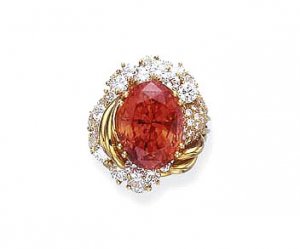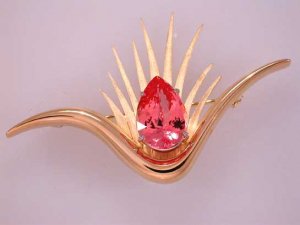- Joined
- Nov 16, 2003
- Messages
- 645
Happy Chanukkah, Merry Christmas and Happy New Year to All,
Just yesterday a received a phone call from a Pricescope member confused about padparadscha sapphire and I note that additional questions have been raised in another thread. So, in the spirit of the season, here is my best explanation.
Padparadscha Sapphire: The following is a quote from a GemWise blog post dated 12.01.06:
"Boldly Going where no lab rat has gone before."
Traditionally we name a gemstone based on species and variety but what happens in the case of a gem that is of the species corundum but derives its name strictly from a mix of colors? What gem am I thinking of? I’ll give you a hint; padparadscha sapphire.
In my book Secrets Of The Gem Trade, The Connoisseur’s Guide To Precious Gemstones, www.secretsofthegemtrade.com, following the late great GIA gemologist Richard Liddicoat, I define padparadscha as a light to medium (delicate) tone of pinkish orange to orangey pink. Up until recently, labs have avoided the issue by simply calling the colors; “pinkish orange” and so forth.
A consortium of gem labs under the title: The Laboratory Manual Harmonization Committee (LMHC) met in Milan and has drawn up a standardized definition of padparadscha. The LMHC consists of seven of the world’s major laboratories (AGTA Gem Testing Center, CISGEM (Milan), GAAJ (Japan), GIA (USA), Gemological Institute of Thailand, Gübelin Gem Lab (Switzerland) and SSEF Swiss Gemmological Institute (Switzerland). Some of these labs, excluding for the moment GIA-GTL, have begun to call and consumers have begun to demand a lab certificate that uses the term padparadscha to describe the stone. The question is, where is this definition coming from and is this the beginning of a brave new world wherein laboratory gemologists begin to dictate to dealers and connoisseurs?
“Well”, I can hear you say, “somebody’s got to cut through all the confusion.” and I agree. But, be careful what you wish for. Leaving aside the question of how this definition was arrived at, like it or not, once established the criteria determined by the labs will become the accepted definition. Are we ready for this and what in the training of a gemologist prepares them for this role? I received my Graduate Gemologist diploma some years back and I can tell that what a neophyte Graduate Gemologist doesn’t know about quality in gemstones would fill many volumes. A newly minted G.G. is little more than an apprentice scientist. Oh sure, he learns the GIA diamond grading system but…
According to Richard Hughes well known author and gemologist with the AGTA gem laboratory which makes him one of the most prominent lab-rats, laboratories have no business making such calls. He was particularly upset by the fact that the LMHC did not include a representative from Sri Lanka at the meetings where the decision was made (I mean where does the term come from?). Hughes also had problems with the adoption of a printed color chart developed by Franck Notari (GIA Geneva). Hughes makes the point that the definition of padparadscha is fuzzy at best and he feels that the insistence on hard a fast definitions is not appropriate. As proof of this assertion, Hughes did an analysis and discovered that the magnificent 20.84 carat padparadscha (pictured below) that sold last year at Christies falls outside the parameters as defined by the chart adopted by the LMHC.
The Question of Origin:
One member recently made the point that some experts contend that only gems from Sri Lanka can be properly called padparadscha. Well that is true enough, some people take that position. The LMHC's position is that padparadscha is a color not a country. Given that these labs will be the ones that are consulted and are now issuing "Padparadscha" certificates, it seems to me that their position will prevail.
Hopefully this will help to dissipate some of the confusion. It is important to note that there are few fast, easy answers to questions of quality in gemstones. Much depends on your point of view. IMO the smart collector ignores branding. Kashmir Sapphire, Burma ruby, Padparadscha sapphire are brand names. Prior to the invention of the geographic certificate they were quality designations. Yes, the best sapphire in the world is probably a Kashmir but assuming the inverse is a logical fallacy, a snare and a delusion. The father of a good friend of mine, who is one of the world's experts on sapphire once told me. "The best Kashmir I ever saw was from Ceylon." Look at the rock!

Just yesterday a received a phone call from a Pricescope member confused about padparadscha sapphire and I note that additional questions have been raised in another thread. So, in the spirit of the season, here is my best explanation.
Padparadscha Sapphire: The following is a quote from a GemWise blog post dated 12.01.06:
"Boldly Going where no lab rat has gone before."
Traditionally we name a gemstone based on species and variety but what happens in the case of a gem that is of the species corundum but derives its name strictly from a mix of colors? What gem am I thinking of? I’ll give you a hint; padparadscha sapphire.
In my book Secrets Of The Gem Trade, The Connoisseur’s Guide To Precious Gemstones, www.secretsofthegemtrade.com, following the late great GIA gemologist Richard Liddicoat, I define padparadscha as a light to medium (delicate) tone of pinkish orange to orangey pink. Up until recently, labs have avoided the issue by simply calling the colors; “pinkish orange” and so forth.
A consortium of gem labs under the title: The Laboratory Manual Harmonization Committee (LMHC) met in Milan and has drawn up a standardized definition of padparadscha. The LMHC consists of seven of the world’s major laboratories (AGTA Gem Testing Center, CISGEM (Milan), GAAJ (Japan), GIA (USA), Gemological Institute of Thailand, Gübelin Gem Lab (Switzerland) and SSEF Swiss Gemmological Institute (Switzerland). Some of these labs, excluding for the moment GIA-GTL, have begun to call and consumers have begun to demand a lab certificate that uses the term padparadscha to describe the stone. The question is, where is this definition coming from and is this the beginning of a brave new world wherein laboratory gemologists begin to dictate to dealers and connoisseurs?
“Well”, I can hear you say, “somebody’s got to cut through all the confusion.” and I agree. But, be careful what you wish for. Leaving aside the question of how this definition was arrived at, like it or not, once established the criteria determined by the labs will become the accepted definition. Are we ready for this and what in the training of a gemologist prepares them for this role? I received my Graduate Gemologist diploma some years back and I can tell that what a neophyte Graduate Gemologist doesn’t know about quality in gemstones would fill many volumes. A newly minted G.G. is little more than an apprentice scientist. Oh sure, he learns the GIA diamond grading system but…
According to Richard Hughes well known author and gemologist with the AGTA gem laboratory which makes him one of the most prominent lab-rats, laboratories have no business making such calls. He was particularly upset by the fact that the LMHC did not include a representative from Sri Lanka at the meetings where the decision was made (I mean where does the term come from?). Hughes also had problems with the adoption of a printed color chart developed by Franck Notari (GIA Geneva). Hughes makes the point that the definition of padparadscha is fuzzy at best and he feels that the insistence on hard a fast definitions is not appropriate. As proof of this assertion, Hughes did an analysis and discovered that the magnificent 20.84 carat padparadscha (pictured below) that sold last year at Christies falls outside the parameters as defined by the chart adopted by the LMHC.
The Question of Origin:
One member recently made the point that some experts contend that only gems from Sri Lanka can be properly called padparadscha. Well that is true enough, some people take that position. The LMHC's position is that padparadscha is a color not a country. Given that these labs will be the ones that are consulted and are now issuing "Padparadscha" certificates, it seems to me that their position will prevail.
Hopefully this will help to dissipate some of the confusion. It is important to note that there are few fast, easy answers to questions of quality in gemstones. Much depends on your point of view. IMO the smart collector ignores branding. Kashmir Sapphire, Burma ruby, Padparadscha sapphire are brand names. Prior to the invention of the geographic certificate they were quality designations. Yes, the best sapphire in the world is probably a Kashmir but assuming the inverse is a logical fallacy, a snare and a delusion. The father of a good friend of mine, who is one of the world's experts on sapphire once told me. "The best Kashmir I ever saw was from Ceylon." Look at the rock!











300x240.png)